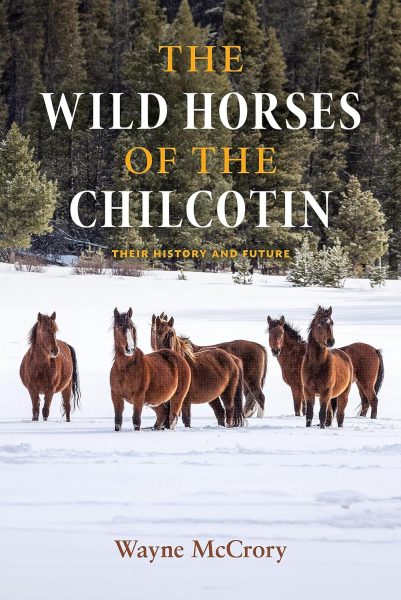
The Wild Horses of the Chilcotin: Their History and Future
Review By Annie Booth
May 9, 2024
BC Studies no. 221 Spring 2024 | p. 247-248
The last 2,800 wild horses still roaming free in the West Chilcotin wilderness and those maintained by First Nations on scattered Indian reserves in BC are cultural reminders of the rich Indigenous equestrian past. They are promises for a better future. The thousands of wild-horse bones scattered across the BC grasslands are reminders of what once was.
The Wild Horses of the Chilcotin (181)
This is not a scholarly book, although it is definitely a book scholars will find interesting. Rather it is a book of many intersecting discussions that will appeal to a wide range of people, from those curious about the natural history of a rather unknown region of British Columbia, to those interested in Tsilhqot’in culture, to those keen on Human-Animal Studies or who have ever wondered what a biologist does for a living. And of course, it will appeal to anyone who devoured horse stories as a kid and is looking for a grown-up horse tale.
More specifically, it is a love letter from a biologist who began his journey with wild horses thinking them a feral pest to be eradicated in the name of ecosystem preservation (much like feral goats in the Galapagos) but acquired an appreciation for the complex role that they play in a still-functioning ecosystem and in an Indigenous culture with a long history of interrelationships with their equine neighbors. It is a naturalist’s personal and professional journey into an unexpected world. Finally, it is the story of the fight to protect a unique BC ecosystem under perpetual threat from cattle ranchers and timber companies, who see horses, wolves and grizzlies as threats in need of extermination and protection efforts as a barrier to removing every last saleable tree.
McCrory weaves a number of storylines into one very readable book. The history of the Chilcotin and the people who have resided there for thousands of years, as well as more recent arrivals, is a central component. Much of the history and knowledge about the area, McCory states, he has derived not just from research, but from many conversations with knowledge holders and Elders of the Xeni Gwet’in Tsilhqot’in and their efforts to protect their culture and the ecosystem that is the foundation of that culture. McCrory is careful to place the horses both with a cultural context as well as making a case for their ecological role.
McCrory, a consulting biologist, now makes the case for wild horses as not being feral intruders but a valuable part of a functioning ecosystem. He documents an important role in predator-prey cycles over centuries while also being unable to document the landscape degradation that the BC government (and a powerful ranching industry) uses as a justification for efforts to eradicate the horses. In order to demonstrate that the horses have been in the region since before European explorers, a substantive chunk of the book examines the genetic history of the horse herds, tracing their origin story. To be fair, this part might be of interest to a smaller group of readers, but it serves as one of the bases to support the Xeni Gwet’in Tsilhqot’in their case for protecting and preserving the herds.
The book is, I suspect, aimed at developing public support for the protection of the wild horses, much as has been done with the Sable Island ponies, along with support for the preservation of an endangered ecosystem and the Tsilhqot’in culture and rights (they gained title to part of their traditional lands in 2014). It makes an excellent case for BC’s wild horses and is a worthwhile read.
Publication Information
McCrory, Wayne. The Wild Horses of the Chilcotin: Their History and Future. Madeira Park, BC: Harbour Publishing. 2023. 368 pp. $39.95 hardcover.
